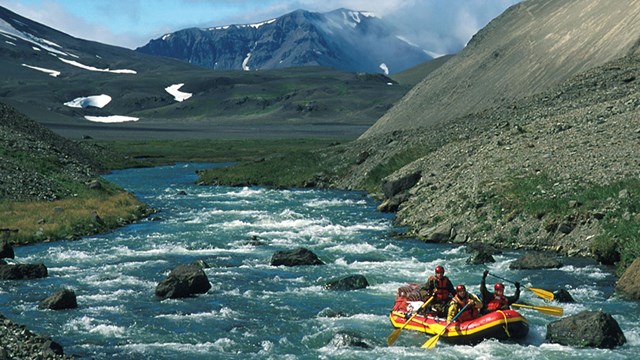The Great White North. The Last Frontier. The Land of The Northern Lights.
It’s been called many things over the centuries, from its various Indigenous monikers — the Aleut called it x̂sxax̂, the Inupiaq “Alaaskaq,” the Yupik “Alaskaq,” the Tlingit “Anáaski,” the Alutiiq ”Alas’kaaq,” and the Russians, “Аляска” — but present-day citizens call it simply: Alaska.
Those disparate names passed down and ever-evolving over the years speak to the incredible mystery that still permeates the minds of most Americans when they think of the largest state (by land mass), far-flung on the northwest coast of neighboring Canada.
Few Americans, in the grand scheme of things, ever make the long trip to the 49th state in the Union. However, those who do know the experience is singular, nearly indescribable, and more diverse than one may think. Alaska is so much more than the chilly, sub-zero temperatures and snowy tundras that typically spring to mind.
While it’s true that some parts are snow-covered much if not all of the year, the central region near Anchorage is quite temperate, and to the south, where it is warm and wet much of the year, the climate is not much different than some continental states.
The West Coast is also considered reasonably moderate, considering its northern proximity to the Bering Sea. Most of the extreme weather one thinks of can be found primarily in the interior of Alaska, where tundra and winter “desert” abound.
Additionally, Alaska’s history is as storied and diverse as its climate. Indigenous Tribes have inhabited its territory for thousands of years. It is believed that the first small pockets of settlers crossed the famed Bering Land Bridge that connected present-day North America to parts of Siberia some 16,000 years ago. These are thought to be some of the first-ever inhabitants of what would become North America.
Numerous Indigenous Tribes occupied and thrived in parts of the Alaskan territory throughout the millennia. In the 17th century, the first white settlers, Russians, made landfall and formed settlements.
The United States government purchased the Alaskan territory from Tsar Alexander II of Russia, and it became an important military outpost. Over the ensuing decades, the population grew as military installations grew across the territory. Then, on Jan. 3, 1959, Alaska became an official U.S. state.
With a history as long and storied as that, it would be no surprise that Alaska contains a wealth of natural and historical treasures to see, experience, and learn from. Luckily, many of these treasures are preserved and commemorated by its five national monuments, and these spots are must-visits for anyone traveling to the mysterious 49th state.
Read below to find out more about what Alaska has to offer!
Misty Fjords National Monument: When one dreams of the jaw-dropping majesty of the Alaskan landscape, the dreamer could very well be picturing this incredible Alaskan Monument. Established in 1978 by President Jimmy Carter, Misty Fjords protects more than 2 million acres of pristine Alaskan wilderness. Thousands of years ago, the ice sheets that covered the land melted, carving deep fjords with thousands-foot-high cliffs that make for this stunning backdrop against the Alaskan sky. Mineral springs and volcanic lava flows can be found deep in the wilderness here, and the springs brim with king salmon. This site is a truly Alaskan experience that cannot be missed.
Photo Courtesy fs.usda.gov
Admiralty Island National Monument: On the southern tip of Alaska, skirting continental Canada, this island chain, part of the Tongass National Forest, is a hidden treasure for outdoor lovers looking for adventure in nature. Admiralty Island is a well-trodden hotspot for tourists and serious outdoors people, where opportunities to fish, hike, boat, camp, and hunt abound. The most adventurous can embark on the 32-mile Admiralty Canoe Route, traversing the entire island. Visitors can also go to the Pack Creek Brown Bear Viewing Area to see the majestic native creatures in their natural habitat.
Photo Courtesy Alaska’s National Forests / US Forest Service by Mackenzie Schultz
Cape Krusenstern National Monument: All the way on the other side of the state lies another natural wonderland just waiting to be experienced. Cape Krusenstern lies north of the Arctic Circle and is home to a vast wetland system that houses a diverse collection of water mammals and fowl. The unique ridges formed by the changing tides and ice flow continue to evolve much as they have for the last 5,000 years, and there remains evidence of human habitation dating back to that time. Today, the area is still used for recreational and commercial marine hunting.
Photo Courtesy NPS
Aniakchak National Monument and Preserve: This spot is not for the faint of heart! One of the most remote and least visited monuments in the National Park System, Aniakchak is filled with as much untouched Alaskan beauty as one is likely to find anywhere in the state. This location is the place for those seeking extreme challenges in nature. Hike, explore, or paddle the Aniakchak River, but keep a lookout for the preserve’s true inhabitants: bears. These massive creatures live in various habitats within Aniakchak, and visitors should always be wary when visiting. The other main highlight is the incredible six-mile-wide caldera formed almost 4,000 years ago by volcanoes. This destination is truly a special and memorable place.
Photo Courtesy NPS
Aleutian Islands WWII National Monument: Alaskan history is synonymous with early American military history, and this site preserves a piece of that. While unknown to many Americans, parts of the Aleutian Islands were invaded by Japanese forces during the battles in the Pacific during World War II, including a 15-month air war and one of the bloodiest battles of the Pacific campaign. The area is now a part of the Alaska Maritime National Wildlife Refuge and protects numerous species of birds, reindeer, and fisheries. Today, visitors can also see the sites of multiple battles and monuments to the sacrifices soldiers and citizens made in those trying and deadly years during the Second World War.
Photo Courtesy NPS





